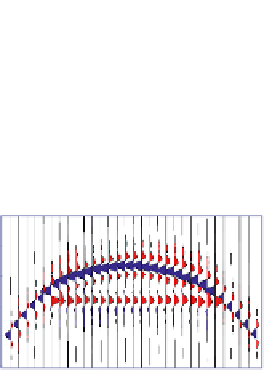Geoscience Reference
In-Depth Information
Impedance
Impedance
Impedance
Shale
Shale
Shale
Oil/gas sand
Oil/gas sand
Oil/gas sand
Brine sand
Brine sand
Brine sand
Bright spot Polarity reversal Dim spot
Red = hard loop (impedance increase) Blue = soft loop (impedance decrease)
Fig. 5.5
Schematic models for oil and brine sand response.
in three possible cases. This general idea is valid for both standard full-offset stacks and
the near and far trace sub-stacks that we shall discuss in the next section, although which
picture applies may depend on what offset range we look at. On the left we have the case
where a brine sand is softer (lower impedance) than the overlying shale. The presence
of oil or gas will make it softer still. We therefore see an increase in amplitude over
the crest of the structure where the hydrocarbon is present. This is the classic 'bright
spot'. Of course, an amplitude increase might also be caused by a lithological effect,
for example a decrease in sand impedance due to porosity increase. A key test is that
we would expect the bright spot, if it is really the result of hydrocarbons, to conform to
structure; in map view, the amplitude change should follow a TWT contour (or strictly
speaking, a depth contour after time-depth conversion, though over a limited area the
TWT and depth contours are often similar in shape). We also hope to see a 'flat spot' at
the hydrocarbon-water contact. This is always a hard reflector (impedance increase).
The flat spot should be at the same TWT as the amplitude change. (If we have both
oil and gas present, then we may see two flat spots, one at the gas-oil contact and one
at the oil-water contact, with matching amplitude steps in the top reservoir reflector,
from very bright in the gas-bearing part to bright in the oil-bearing part.) In the middle,
we see the case where the brine sand is hard relative to the overlying shale, but the
hydrocarbon sand is soft. The top sand will be a hard loop below the fluid contact and
a soft loop above it, with a polarity change at the contact. This case is often difficult to
interpret with confidence, particularly if the structure is affected by minor faulting. It is
often possible to keep the top sand pick on a hard loop across the crest by interpreting
a small fault near the contact. Inspection of lines in different azimuths across the crest












